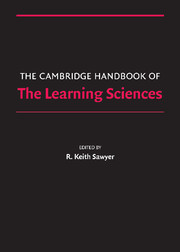Book contents
- Frontmatter
- Contents
- Preface
- Contributors
- 1 Introduction
- PART I FOUNDATIONS
- PART II METHODOLOGIES
- 8 Learner-Centered Design
- 9 The Evolution of Design Studies as Methodology
- 10 Design-Based Research
- 11 Guiding Inquiry-Based Math Learning
- 12 Analyzing Collaborative Discourse
- 13 Assessing for Deep Understanding
- PART III THE NATURE OF KNOWLEDGE
- PART IV MAKING KNOWLEDGE VISIBLE
- PART V LEARNING TOGETHER
- PART VI LEARNING ENVIRONMENTS
- Afterword: After How Comes What
- Epilogue: The Fundamental Issue in the Learning Sciences
- Author Index
- Subject Index
- References
10 - Design-Based Research
A Methodological Toolkit for the Learning Scientist
Published online by Cambridge University Press: 05 June 2012
- Frontmatter
- Contents
- Preface
- Contributors
- 1 Introduction
- PART I FOUNDATIONS
- PART II METHODOLOGIES
- 8 Learner-Centered Design
- 9 The Evolution of Design Studies as Methodology
- 10 Design-Based Research
- 11 Guiding Inquiry-Based Math Learning
- 12 Analyzing Collaborative Discourse
- 13 Assessing for Deep Understanding
- PART III THE NATURE OF KNOWLEDGE
- PART IV MAKING KNOWLEDGE VISIBLE
- PART V LEARNING TOGETHER
- PART VI LEARNING ENVIRONMENTS
- Afterword: After How Comes What
- Epilogue: The Fundamental Issue in the Learning Sciences
- Author Index
- Subject Index
- References
Summary
Design-based research (DBR) is used to study learning in environments which are designed and systematically changed by the researcher. The goal of DBR is to use the close study of a single learning environment, usually as it passes through multiple iterations and as it occurs in naturalistic contexts, to develop new theories, artifacts, and practices that can be generalized to other schools and classrooms. In describing design-based research, Cobb et al. (2003) state:
Prototypically, design experiments entail both “engineering” particular forms of learning and systematically studying those forms of learning within the context defined by the means of supporting them. This designed context is subject to test and revision, and the successive iterations that result play a role similar to that of systematic variation in experiment.
(p. 9)This design process allows the researcher to move beyond simply understanding the world as it is, and involves working to change it in useful ways with the broader goal of examining how these systematic changes influence learning and practice (Barab & Squire, 2004). It is this innovative aspect of design-based research that makes it such a useful methodology for advancing new theory and practice.
One way of understanding the focus of design-based research is in terms of Pasteur's Quadrant (Stokes, 1997; see Figure 10.1). In this quadrant model for characterizing scientific research, the upper-left-hand cell consists of basic research for the sole purpose of understanding without an eye toward practical use.
- Type
- Chapter
- Information
- The Cambridge Handbook of the Learning Sciences , pp. 153 - 170Publisher: Cambridge University PressPrint publication year: 2005
References
- 6
- Cited by



